 Tobias Seelig, about 1850-1892 Dry Goods Merchant Buried in Pioneer & Military Memorial Park, exact location unknown. (Stock image of men wearing Prince Albert suits, courtesy of MicroSoft clip art) According to his various voter registrations, Tobias Seelig was born in Germany around 1850. The passenger list of the ship Humboldt shows that he arrived at New York’s Castle Garden on August 18, 1865. Except for that, his entire life prior to 1878 is a blank.
Late in 1878, he appears to have opened a dry goods store in Modesto, California. The Mechanics Cash Store carried clothing, boots, and other fancy goods on a cash-only basis. The local newspaper listed some of the items available. By 1880, Tobias’s younger brother Gabriel joined him in the Modesto dry goods store. Perhaps Gabriel took over the management of the Modesto store, for Tobias was in Phoenix by June 1882. He must have been naturalized, because he registered to vote in that year. After a stint as a clerk for the dry goods firm of Rosenthal & Kutner, he opened a cigar store in or near the Capitol Saloon. The cigar store burned down in 1886. The Seeligs were Jewish. Jewish stores were essential to life in early Phoenix, and most were subsidiaries of stores founded in California during the Gold Rush days. Their proprietors could therefore count on financial backing from bankers in San Francisco as well as established sources of supply from the West Coast. Phoenix’s merchants were usually ‘Reform’ Jews with German surnames who kept their religious affiliations low-key and practiced them behind closed doors. A Freemason, Seelig also participated in the Fire Brigade and joined the Knights of Pythias. He was generally well-liked and is said to have dressed stylishly. By 1891, he was even investing in local mining operations. Misfortune caught up with him early in 1892, when the Knights of Pythias charged him with defalcation in his use of their funds. Deeply affected by the charge, Seelig took to drinking and apparently made plans to commit suicide. He told a friend that, when he died, he wanted to be laid out in his Prince Albert suit. On March 8, 1892, he carried out his plan in his rooming house, where he donned his suit and shot himself in the temple. Compounding the tragedy was that his fellow Pythians had already taken up a collection of $600 to cover his debts and restore his good name. Seelig was buried in a Phoenix cemetery. Since he owned some property, it is likely that he was interred somewhere in the Pioneer & Military Memorial Park. There is no marker. © 2022 by Donna Carr. Last revised November 11, 2022. If you would like assistance researching our interred, you can find more information on our website. You can contact us at [email protected] at any time. Thank you for your interest to preserve the history of Arizona's pioneers!
0 Comments
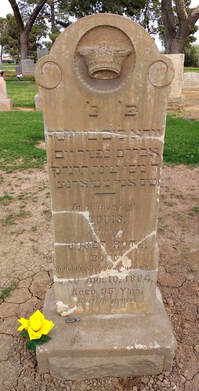 Louis Roth, about 1859-1894 Shopkeeper Originally buried in IOOF; moved to Beth Israel (Grave marker photo courtesy of Tim Kovacs) Louis Roth, son of Yosef Avraham and his wife Tcharne, was born about 1859 in what is now Kovácsvágás, Borsod-Abaúj-Zemplén, Hungary. He was later known as Louis, Lajos, or Leo.
After the Austrian Hapsburgs teamed up with Tsar Nicholas I of Russia to put down the Hungarian Revolution of 1848, Hungarian Jews lost the few civil rights they had enjoyed and became subject to the Russian military draft. Louis’s older brother Jacob was conscripted in this fashion, prompting their father to urge his other sons to emigrate as soon as possible. Accordingly, Louis and Max, the next two oldest sons, came to America in 1879. Louis appears to have filed a declaration of intent to become a naturalized U.S. citizen under the name of Lewis Roth in Fairfield County, Ohio, on January 30, 1885. By 1888, Louis and his younger siblings had reunited in Los Angeles, where he had found work with the Kline Clothing Company and the Excelsior Clothing Company. The Roth family—Max, Rosa, Kelly, Mike and Isidor—ultimately became very involved in Los Angeles’s Hungarian Jewish community. In January 1888, Louis’s financial position was stable enough for him to marry Miss Fannie Gerson. Unfortunately, the marriage did not last; they divorced just five months later. By January 1891, Louis was in Phoenix, Arizona, operating his own cigar and confectionary shop on Washington Street, near the Monihon Building. It’s possible that he came to Arizona for his health, considering that he died of consumption on April 12, 1894. Louis’s brother Max traveled to Phoenix to see him properly buried in the Independent Order of Odd Fellows Cemetery and to close out his business affairs. When Beth Israel Cemetery opened in 1903, the family had his remains moved there and a fine marble monument erected in his memory. Fast forward to January 2019, when Tim Kovacs was visiting the Beth Israel Cemetery. While there, he happened upon a broken marker on which he recognized the place name KovacsVagas—a Hungarian village about 33 miles from where his own ancestors originated. On February 9, 2021, Tim received a surprising message from Geri Roth Jacobson, Louis Roth’s great-niece. She had spent thirty years looking for a grave marker for her “Uncle Leo” in California, but to no avail. Only by luck had she come upon his memorial on Find A Grave. Because Roth had originally been buried in the IOOF Cemetery, Geri appealed to the Pioneers’ Cemetery Association for help with repairs, and its preservation team responded. The restoration was a success and, on December 21, 2022, Geri and a contingent of relatives from California visited the grave for the first time ever to view the results. © 2024 by Tim Kovacs and Donna L. Carr. Last revised 4 May 2024. If you would like assistance researching our interred, you can find more information on our website. You can contact us at [email protected] at any time. Thank you for your interest to preserve the history of Arizona's pioneers!  Louis A. Geary, 1869-1906 Music Teacher and Orchestra Leader Buried in Rosedale Cemetery (exact location unknown) (Generic image of an orchestra created using Bing AI) According to his 1906 newspaper obituary, Louis A. Geary had been a music teacher and the leader of an orchestra in California before he fell ill with consumption and moved to Phoenix, Arizona, for his health.
Geary was born in 1869, probably in Binghamton, Broome County, New York, to Patrick Geary and Mary Garvey. Patrick was an Irish immigrant and a shoemaker by trade. The Gearys had five children. Although Mr. Geary probably made a respectable living, it is still surprising that three of the Geary children were able to study music. In 1892, Mary E. “Mamie” Geary, the eldest daughter, was listed simply as a music teacher but, by 1895, she was a violin instructor at Ward’s Seminary for Young Ladies in Nashville, Tennessee. She is said to have studied with Madame Dove Boetti, Professor Giuseppe Vecchione, and Madame Carmilla Urso (a violin virtuoso)—all important names in their day. By 1915, Mamie was the head of the New City School of Music in Chicago, and her sister Margaret was a piano instructor in Chicago. Their brother Louis seems to have come to his musical career by a more circuitous route. In 1892, he appeared on the New York State census as a cigar maker. Not until later did he move to California where he taught music and performed with an orchestra. By 1906, Louis Geary was suffering from consumption, and he and his wife came to Phoenix where they took up lodgings on North First Street. Nevertheless, Geary’s health declined rapidly. When he died on May 29th, his widow was practically penniless and sought financial help from the in-laws she had heard about but never met. Geary’s funeral was delayed while Phoenix Marshal Kinney telegraphed his father, who was by then living in Chicago, Illinois. When Geary’s father responded a week after his death, Kinney learned that his family back East had not heard from him in two years and were not even aware that he had married. Perhaps a family rift had caused the Gearys to stop communicating. Louis Geary was buried in Rosedale Cemetery. Since no headstone has been found, the exact location is no longer known. The fate of his widow is also unknown, although she probably returned to California. © 2024 by Donna L. Carr. Last revised 25 April 2024. If you would like assistance researching our interred, you can find more information on our website. You can contact us at [email protected] at any time. Thank you for your interest to preserve the history of Arizona's pioneers! 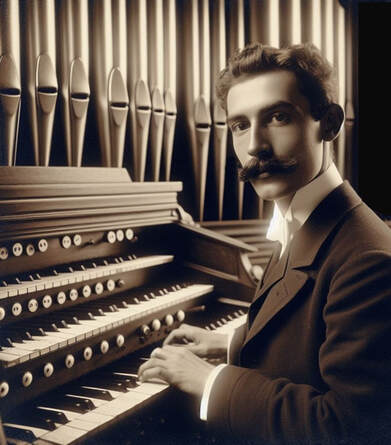 Professor H. Cresswell Shaw 1855 -1902 Organist Buried in Rosedale Cemetery, Block S147, Grave 2 (Generic image created using Bing AI) Henry Cresswell Shaw was born November 1855 in Canada, possibly in Guelph, a city in Ontario about 43 miles from Toronto. Guelph had a strong music and arts tradition. It was also home to the Bell Organ Company. Founded in 1864, it manufactured reed and pump organs, pianos and melodeons, as well as a small number of pipe organs. Perhaps it was not surprising, then that Shaw studied music and became an organist.
In 1881, Shaw seems to have been a music dealer in Guelph when he transcribed for publication a piano arrangement of the song, The Palms (Les Rameaux par Faure). It was dedicated to a Miss Bertie Geddes, a church organist in Hamilton and Guelph, Ontario. A copy exists in the University of Michigan Library. In 1883, Shaw became the organist for St. Peter’s Church in Berlin, Ontario, a position he would hold for the next sixteen years. (Berlin no longer appears on the map as a Canadian city. Its name was changed to Kitchener in 1916 when Canada entered World War I as part of the British Empire. Shaw proved to be a devoted church worker and was especially popular with the young people’s groups. Shaw’s hobby was horticulture. In June 1895, he built Rosehurst Conservatories. With the help of a gardener, the Conservatories grew roses, lilies, and a variety of other hothouse flowers during Canada’s winters. By 1896, Shaw was suffering from Bright’s Disease and sought a warmer climate during the winter. He moved to Phoenix permanently in 1899, having secured a position as organist at the First Methodist Episcopal Church which had recently had its pipe organ refurbished. In the summer of 1901, he made a brief trip—possibly his last—back home to Canada. Shaw died on March 31, 1902, in his rooms at 524 South First Avenue11. The Rev. E. A. Penick conducted his funeral, after which Shaw was buried in Rosedale, Section 147, Grave 2. © 2024 by Donna L. Carr. Last revised 12 April 2024. If you would like assistance researching our interred, you can find more information on our website. You can contact us at [email protected] at any time. Thank you for your interest to preserve the history of Arizona's pioneers! 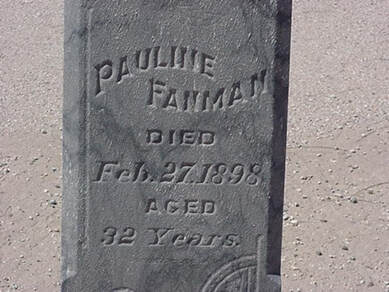 Mary E. “Pauline” Fielder Fayman 1867-1898 Pianist and Singer Buried in Loosley Cemetery, Block 11, Lot 21, Grave 3 (Image courtesy of the Pioneers’ Cemetery Association) Mary E. Fielder was born about 1867 in Georgia. She was the youngest child of Herbert Fielder and Mary Blance. Her father, a lawyer, was a prolific writer involved in southern politics.
Since Mary’s sister Kallura was sent to Ward’s Seminary for Young Ladies (a finishing school) in Tennessee, it seems likely that Mary too attended Ward’s where she became a concert-level pianist and vocalist. Around 1884, the Fielders relocated to Deming, New Mexico, where Mr. Fielder opened a new law office. Here, Mary met and married James William Fayman, a clerk for the Southern Pacific Railroad. The young couple moved to Los Angeles, California in 1887, where they became involved with the social life of the Los Angeles area and were often mentioned in the newspapers. Mary taught music and performed with her students as well as solo. Sometime around 1894, the Faymans moved to Truckee, California. There, Mary became involved in a romantic relationship with a well-known male resident of that city. Their marriage at an end, James returned to Los Angeles and Mary went to live with her brother in Silver City, New Mexico. Mary’s movements during the next few years are difficult to trace, but somewhere along the way she developed a fondness for absinthe, a liquor often associated with artists and a bohemian lifestyle. She is said to have gone to Tucson, Arizona, to sing in saloons and then returned to Los Angeles, where she rented lodgings under the name of Josie Black. She arrived in Phoenix, Arizona, at the end of 1897 where she found employment playing piano and singing at the Anheuser Saloon under the name of Pauline Fayman. Mary had been drinking heavily on the evening of February 27, 1898. Around 1 AM, she returned to her room at the St. Lawrence Hotel where she took a large dose of a white powder. A doctor was summoned but she refused medical help when he arrived, claiming it was only baking soda. She was discovered dead the following afternoon, and a coroner’s inquest determined that she had in fact ingested morphine. The investigation into her death also turned up a photograph that had been torn into pieces. Written on the back of one scrap was “Don’t bury me in a pauper’s grave. Don’t telegraph my brother at Silver City.” Mary’s friends and brother carried out her last wish. She was buried in Loosley Cemetery in Phoenix, Arizona, under the name of Pauline Fayman, although her surname on the grave marker is spelled incorrectly as Fanman. © 2018 by Patty Gault, PCA. Last revised March 2018. If you would like assistance researching our interred, you can find more information on our website. You can contact us at [email protected] at any time. Thank you for your interest to preserve the history of Arizona's pioneers! 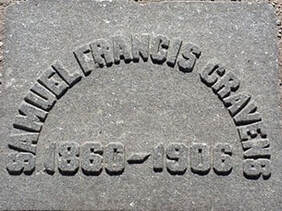 Samuel Francis Cravens 1860-1906 Choral Director and Music Instructor Buried in Porter Cemetery, Block 47, Grave C (Grave marker photo courtesy of the Pioneers’ Cemetery Association, Inc.) Professor S. F. Cravens, a highly-regarded choral director and music instructor, founded the Cravens School of Music with his wife in 1903. Although it lasted less than five years, it was the first of its kind in the Arizona Territory.
Cravens, born 1860 in Missouri, was the son of Joshua Cravens and Mary Catherine Hulett. By 1884, he was a music professor in Albany, Missouri. Samuel very likely met his future bride, Etta Dent, through their shared interest in music. The daughter of William and Lucinda Dent, she was something of a music prodigy. Samuel and Etta were married on April 19, 1887, in Manhattan, Kansas. The young couple opened the first Cravens School of Music in Topeka, Kansas. In 1892, they spent a season in Europe, studying under Oscar Beringer in London. Upon their return to the States, they became directors of music at the University of Denver. Around 1895, Samuel was diagnosed with tuberculosis, and the Cravens decided to move to Ottawa, Kansas, where the winter weather was not as severe. November 1895, Samuel was a professor of vocal music at Ottawa University, a co-ed Christian university in Ottawa, Kansas. Etta Dent Cravens, an accomplished pianist, also taught there. Samuel’s fragile health led the Cravens to alternate between their home in Ottawa during the summer and Phoenix, Arizona, in the winter. They opened a new music school in Phoenix so they would have an income with which to support themselves while there. In spite of his chronic health problems, Samuel Craven still enjoyed some musical triumphs during the summers. The most important one was the Kansas Music Festival in Ottawa, a multi-day event for which Craven organized and directed twelve different choral groups totaling a thousand singers. Samuel died on October 31, 1906, and was buried in Porter Cemetery. After his death, Etta returned to Kansas and reopened the Cravens School of Music in Emporia. Its recitals and concerts were widely attended by the public. She died of breast cancer on April 26, 1921, in Emporia, Kansas. ©2024 by Donna L. Carr. Last revised 31 March 2024. If you would like assistance researching our interred, you can find more information on our website. You can contact us at [email protected] at any time. Thank you for your interest to preserve the history of Arizona's pioneers! 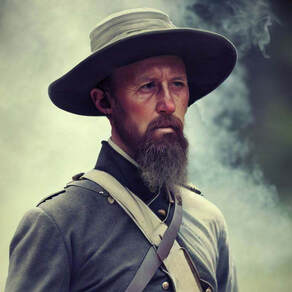 John D. Murphy About 1830-1897 Veteran of the Civil War Buried in Cementerio Lindo, exact location unknown (Image of a Civil War soldier, generated by Bing AI) John David Murphy was a Roman Catholic of Irish descent. Records imply that he was known throughout his life as John D, John David, or Jerry.
In April 1853, John married Sarah C. Jacobus. It was a ‘runaway marriage’ or elopement, so the young couple married in Essex County, New Jersey, where they were not known. The Murphys had five children: Jane, Sarah Elizabeth, Mary, Jerome Franklin, and Loretta. The federal census of 1860 recorded the Murphys living in Orange, Essex County, New Jersey, where John was working as a carpenter. The family seems to have been quite poor. Notwithstanding his age, John D. Murphy volunteered to fight in the Civil War. He enlisted on May 23, 1861, and was assigned to Company F, 72nd New York Infantry. His unit fought in the Peninsular Campaign, and Murphy was reported as wounded at the Battle of Williamsburg on February 5, 1862. After the war, Murphy was unable to work and, by 1880, he was no longer with his family. Family members say that he had developed a mania for wandering around the country. He lived for a time at the Old Soldiers Home in Dayton, Ohio, before heading out for Arizona. Around July 1, 1897, Murphy was living in a boarding house in Phoenix when he fell ill. His landlord cared for him for four days before sending him to the County Hospital. Murphy died there on July 10, 1897, and was buried in the Salt River Cemetery. Upon Murphy’s death, $600 in cash was found among his belongings, as well as letters from his daughter, Mary Murphy Hilliard. When the administrator of Murphy’s estate notified Mary of her father’s demise, he was surprised to learn that Murphy had a wife back in New Jersey. However, she was illiterate and depended on Mary to keep in touch with Murphy. After Mr. Murphy’s final expenses were deducted, his widow Sarah received what was left--$486. She was still living in 1910, when she was recorded on the federal census as residing on a farm in Montana, with her son Franklin and his wife. © 2023 by Donna L. Carr. Last revised 24 September 2023. If you would like assistance researching our interred, you can find more information on our website. You can contact us at [email protected] at any time. Thank you for your interest to preserve the history of Arizona's pioneers! 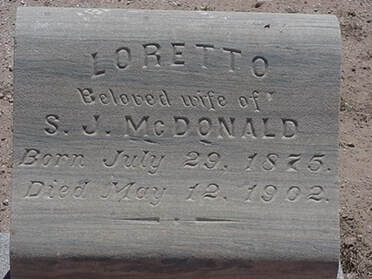 Loretta Mary Huntington McDonald 1875-1902 Teacher Buried in Rosedale Cemetery North (Grave marker photo courtesy of the Pioneers’ Cemetery Association) Loretta was born in Halleck, Elko County, Nevada on July 29, 1875 to Cornelius Edson Huntington and Sarah nee O’Connor. At the time of her birth, her father was a soldier in the U.S. Army’s 12th Infantry, Company H, stationed at Camp Halleck. Camp Halleck had been established to protect the California Trail and construction workers of the Central Pacific Railroad. Shortly after Loretta’s birth, he was promoted to commissary sergeant.
Sgt. Huntington was reassigned to Camp Independence in Inyo County, California in 1876. Thereafter, the family remained in California while Loretta’s father was transferred from post to post. By 1880, they were living in San Diego, and three additional children had been added to the household: Edson (born 1876 in Nevada), Daniel (born 1878 in California), and Adele (born November 1879 in California). Another son, Paul, was born in 1883. After Huntington’s discharge from the military, he worked as a bookkeeper in San Pedro, California. This is where he died on August 24, 1893.* Loretta and the rest of the family had moved to Phoenix, Arizona, between 1880 and 1890, where Loretta entered college to become a teacher. Newspapers describe a young lady who enjoyed her friends and traveling to Prescott during the summer with her sister Adele. Loretta taught school for several years before marrying Samuel John McDonald, a stockman, on August 27, 1900. However, the couple had no children and Loretta was eventually diagnosed with tuberculosis. By 1901, her health had begun a steady decline. She died May 12, 1902, surrounded by her family, and was buried in Rosedale Cemetery. Her husband Samuel remained in Phoenix, unmarried, until about 1909, when he left for parts unknown. Both Loretta’s sister, Adele Walters, and brother, Paul Huntington, also succumbed to tuberculosis and appear to be buried near her in Rosedale Cemetery. *There is a discrepancy regarding when Cornelius died. His wife Sarah applied for a widow’s pension in August 16, 1890, while in Arizona, but the death record in California clearly shows that his name was not added to the register page until 1893. © 2020 by Patricia Gault. Last revised March 2020. If you would like assistance researching our interred, you can find more information on our website. You can contact us at [email protected] at any time. Thank you for your interest to preserve the history of Arizona's pioneers! 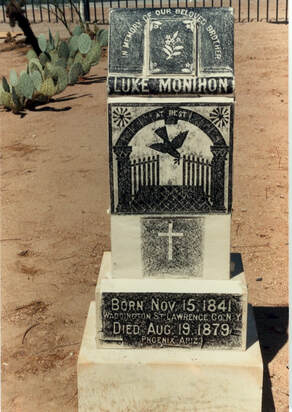 Luke Monihon 1841-1879 A Rancher Murdered Buried in City Loosley Cemetery, Block 2, Lot 6, north half (Grave marker photo courtesy of Pioneers’ Cemetery Association, Inc.) Luke Monihon was born on November 15, 1841, in Waddington, St. Lawrence County, New York. He was the son of James Monaghan and Ann Martin, immigrants from Ireland who had arrived in the United States between 1833 and 1837. The Monaghans were farmers.
James Davidson Monihon, Luke’s older brother, caught ‘gold fever’ in 1854 and went off to California to become a placer miner. In 1860, Luke was working as a hired hand for a Rutherford family, also in St. Lawrence County. No evidence has been found that Luke himself served during the Civil War, although his brother James enlisted in Company F, 1st California Infantry, which brought him to Arizona in 1863. Evidently James saw potential in the Salt River Valley and invited his brothers to join him. Of Luke’s and James’s siblings, Joseph and Christopher also came to Arizona. While their kin back in New York continued to spell their surname as Monaghan, the brothers in Arizona were known as Monahans, Monahons and, finally--Monihons. Luke Monihon was in Arizona by at least August 1875, when he filed on a homestead near his brother James’s, in the new Phoenix township. After “proving up," he received his homestead patent in May 1878. He married Sarah Elizabeth Wilcoxen, daughter of his neighbor Andrew Jackson Willcoxen, although the marriage appears to have been of short duration and there were no children. Sarah had been married previously and had a son by her first husband. On August 19, 1879, Monihon was driving home with a load of wood when he was shot in the back by an assailant who had been lying in wait along the road. The team of horses continued home where a ranch hand, seeing no driver, backtracked and found Monihon’s body. The following morning, deputy sheriffs Blankenship and Garfias picked up the trail of a man on foot near the site of the murder. A Maricopa Indian tracker followed the trail to the ranch of Monihon’s father-in-law, A. J. Willcoxen. The boot track was found to match that of John Keller, one of Willcoxen’s ranch hands who had reportedly been infatuated with Luke’s wife Sarah. The deputies arrested Keller but he was lynched by an angry mob a few days later. Monihon was originally buried in in the first Phoenix cemetery, but his grave was relocated to Loosley Cemetery after it opened in 1884. Monihon’s widow Sarah sold his ranch shortly thereafter, and the entire Willcoxen family moved to Ventura, California, to escape local opprobrium. © 2024 by Donna L. Carr. Last revised 27 February 2024. If you would like assistance researching our interred, you can find more information on our website. You can contact us at [email protected] at any time. Thank you for your interest to preserve the history of Arizona's pioneers! 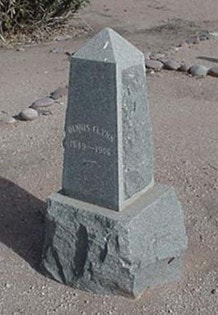 Dennis Flynn About 1849-1906 Miner Buried in Porter Cemetery, Block 47, Space E (Grave marker photo courtesy of the Pioneers’ Cemetery Association, Inc.) Dennis Flynn was born about 1849 in Ireland. He came from Ireland to Boston at a young age, and an uncle provided for his schooling. He was in Virginia City, Nevada, during the height of the Comstock Lode in the 1870s. From there, he moved to Austin, Nevada, and Grass Valley, California. His name being a common one, it has not been possible to document his movements before he arrived in Arizona.
After moving to Arizona, he resided mostly in Yavapai County. He was a construction foreman on the Walnut Grove Dam at some point between 1886 and 1890. From about 1898 on, Flynn lived in Yarnell. The 1900 census recorded Flynn living in a boarding house in Wagoner, Yavapai County. He was single, said he came to the United States in June 1884 (perhaps he meant Arizona?), and was not a citizen, although he had registered to vote in Arizona from 1892 on. In 1900, he was a foreman at the Crown Point mine owned by Alexander Brodie. Flynn was a miner for about 25 years, although he apparently supplemented that income with other jobs. In 1905, he was road overseer for the county road from Kirkland to Congress and Octave. Somewhere along the way, Flynn contracted tuberculosis and his health began to fail. Seeking a warmer environment, he came from Peeples Valley to Phoenix on December 7, 1906, and took lodgings at the Commercial Hotel. Scarcely a day later, he was stricken unexpectedly and taken to Sisters hospital by his friend Ross Moore. That hospital being full, he was taken to the County hospital, where he died on December 9th. Another friend, Leopold Wallrath, arranged the funeral. Flynn’s obituary describes him as being of a pleasant and kind-hearted disposition who would be missed by those who knew him. He had no known relatives in this part of the country. Flynn was buried with a fine granite marker in Porter, Block 47, Space E. Although he was believed to have owned several mining claims, no probate has been found. © 2023 by Donna L. Carr. Last revised 30 December 2023. If you would like assistance researching our interred, you can find more information on our website. You can contact us at [email protected] at any time. Thank you for your interest to preserve the history of Arizona's pioneers! |